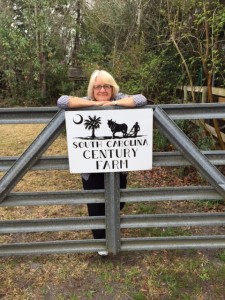My Grandfather’s History Home
My grandfather’s house is not listed on the National Register of Historic Places but it probably ought to be. It’s one of those buildings built by a farmer for his family just after the turn of the century. My father, Alec Peeples Vaughan, Jr. said that his father, Alec Sr. and his brother Brook planed every board that went into the building of that house. Daddy said that the shavings from the wood planing were so high that their knees could not be seen.
This old house is a 5 bedroom, no bath home with a parlor for entertaining on the front, a porch for shelling peas and a kitchen built off of the back of the house to protect the house from fire. There are 2 fireplaces in the home; one in the parlor, and front room and 2 pot bellied stoves; one in the kitchen and the other in Papa’s bedroom in the center of the house.
Many call this old someplace a “shot gun” home because it has a long hallway in the center dividing the 6 rooms; 3 on each side.
This home is symbolic of the old farm place of the 19th century. It was built around 1911 and has served as a farm house up until the time my grandfather died about 1976.
National Register homes have 4 criteria to qualify: 1. Event-The property must make a contribution to American History. This house certainly makes a contribution to the hard work and determination of a family to run a farm on over 120 acres of land. 2. Person- The house must be associated with significant people of America’s past. My grandfather, Alec Peeples Vaughan, Sr., was supervisor of the “poor” farm in Hampton, South Carolina. He traded chickens and corn to help keep shoes on the feet of little children both Black and White. He taught Sunday School at Sandy Run Baptist Church for some 14 years without every missing a Sunday and helped in the neighborhoods that needed food and clothing. I’d say he has been quite significant. 3. Design/Construction- This old house is important in terms of the “shot gun” house of the farm days and it was certainly built to last. 4. Information Potential- It is likely to yield information important to history as time goes forward.
According to the listings about National Registry homes, there are some places that do not need listing including cemeteries, birthplaces, graves, moved structures, reconstructed historic buildings, commemorative properties and properties that have achieved significance in the last fifty years.
While my grandfather’s home is not listed on the National Registry, it’s certainly listed in my heart as one of the most significant houses in South Carolina for in that house was great love, care, and wonder. Those who lived there learned a work ethic that is carried out today and I’m so proud to have had the heritage attached to it.
Josie
Click Below To Visit Our Store
Archives
- July 2020
- April 2020
- March 2020
- October 2019
- February 2018
- January 2018
- December 2017
- November 2017
- October 2017
- September 2017
- August 2017
- July 2017
- June 2017
- March 2017
- January 2017
- November 2016
- October 2016
- September 2016
- August 2016
- July 2016
- March 2016
- February 2016
- January 2016
- December 2015
- November 2015
- October 2015
- September 2015
- August 2015
- July 2015
- June 2015
- May 2015
- April 2015
- March 2015
- February 2015
- January 2015
- December 2014
- November 2014
Up and Coming Events
| M | T | W | T | F | S | S |
|---|---|---|---|---|---|---|
| 1 | ||||||
| 2 | 3 | 4 | 5 | 6 | 7 | 8 |
| 9 | 10 | 11 | 12 | 13 | 14 | 15 |
| 16 | 17 | 18 | 19 | 20 | 21 | 22 |
| 23 | 24 | 25 | 26 | 27 | 28 | 29 |
| 30 | ||||||




